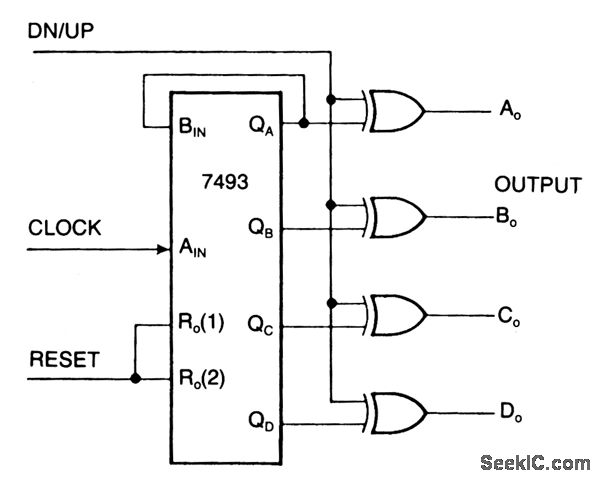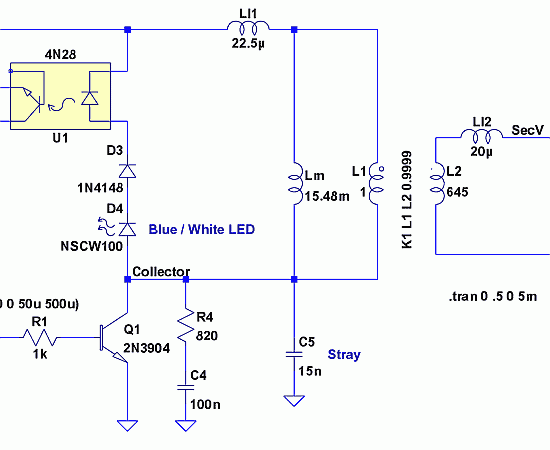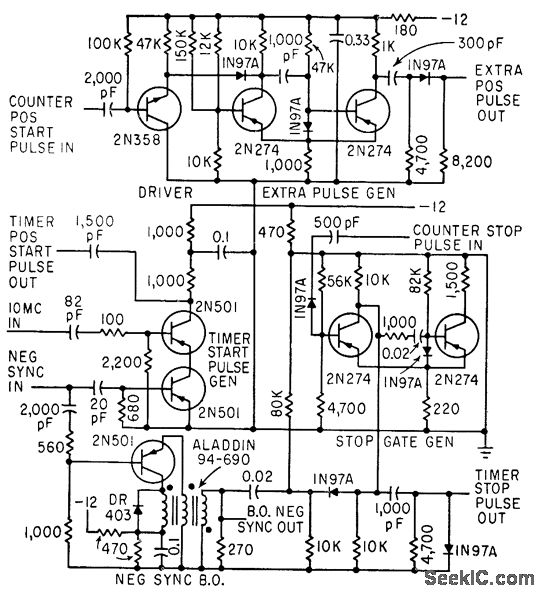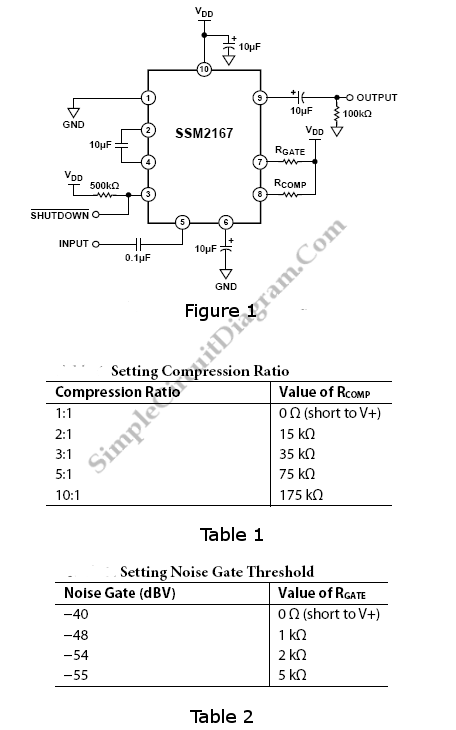
XOR GATE UP DOWN COUNTER

An ordinary binary counter, such as the 7493, can be transformed into an up/down counter with mode control by integrating XOR gates (7486) to the counter's outputs. The circuit counts upwards when the DN/UP line is low and downwards when the DN/UP line is high. To utilize the 7493 counter for its maximum count range of 0 to 15, connect the QA output to the BIN input and apply clock pulses to the AIN input. The reset input, when high, disables the count inputs and simultaneously resets the outputs AO through DO to low in up-count mode or to 15 in down-count mode. For normal counting operation, the reset input must be low. This counter can be easily cascaded by connecting the QD line to the clock input of a subsequent counter.
The 7493 binary counter is a versatile component in digital electronics, capable of counting in both ascending and descending order. By incorporating the 7486 XOR gates, the counter can be configured to switch its counting mode based on the state of the DN/UP control line. This flexibility allows for dynamic counting applications where the direction of count may need to be altered based on external conditions.
In the up-count mode, the counter increments its value with each clock pulse applied to the AIN input, while the QA output reflects the least significant bit of the count. When the DN/UP line is asserted low, the counting sequence proceeds from 0 to 15. Conversely, in the down-count mode, when the DN/UP line is high, the counter decrements its value, starting from 15 and counting down to 0.
The reset functionality of the counter is critical for initializing the counting sequence. When the reset input is held high, it not only inhibits the counting operation but also ensures that the outputs are set to a predefined state, either 0 or 15, depending on the counting direction. This reset capability is essential for applications requiring precise control over the counting process.
Cascading multiple 7493 counters enhances the counting range and allows for more complex counting applications. By connecting the QD output of one counter to the clock input of another, a multi-stage counting system can be created, enabling counts beyond the inherent limit of a single counter. This cascading approach is particularly useful in applications such as digital clocks, frequency counters, and event counters, where extended counting capabilities are necessary.
Overall, the combination of the 7493 binary counter and the 7486 XOR gates offers a powerful solution for applications requiring flexible counting mechanisms, with the ability to easily reset and cascade for extended functionality.One can transform an ordinary binary counter, such as a 7493, into an up/down counter with mode control by adding XOR gates 7486 to the counter`s outputs. The circuit counts up when the DN/UP line is low and down when the DN/UP line is high. To use the 7493 counter to count out its maximum count length of 0 - 15, connect the QA output to the BIN i
nput and apply clock pulses to the AIN input. The reset input, when high, inhibits the count inputs and simultaneously retums the outputs AO through DO to low in the up-count mode or 15 in the down-count mode. For normal counting, the reset input must be low. 0ne can easily cascade this counter by feeding the QD line to the clock input of a succeeding counter.
🔗 External reference
The 7493 binary counter is a versatile component in digital electronics, capable of counting in both ascending and descending order. By incorporating the 7486 XOR gates, the counter can be configured to switch its counting mode based on the state of the DN/UP control line. This flexibility allows for dynamic counting applications where the direction of count may need to be altered based on external conditions.
In the up-count mode, the counter increments its value with each clock pulse applied to the AIN input, while the QA output reflects the least significant bit of the count. When the DN/UP line is asserted low, the counting sequence proceeds from 0 to 15. Conversely, in the down-count mode, when the DN/UP line is high, the counter decrements its value, starting from 15 and counting down to 0.
The reset functionality of the counter is critical for initializing the counting sequence. When the reset input is held high, it not only inhibits the counting operation but also ensures that the outputs are set to a predefined state, either 0 or 15, depending on the counting direction. This reset capability is essential for applications requiring precise control over the counting process.
Cascading multiple 7493 counters enhances the counting range and allows for more complex counting applications. By connecting the QD output of one counter to the clock input of another, a multi-stage counting system can be created, enabling counts beyond the inherent limit of a single counter. This cascading approach is particularly useful in applications such as digital clocks, frequency counters, and event counters, where extended counting capabilities are necessary.
Overall, the combination of the 7493 binary counter and the 7486 XOR gates offers a powerful solution for applications requiring flexible counting mechanisms, with the ability to easily reset and cascade for extended functionality.One can transform an ordinary binary counter, such as a 7493, into an up/down counter with mode control by adding XOR gates 7486 to the counter`s outputs. The circuit counts up when the DN/UP line is low and down when the DN/UP line is high. To use the 7493 counter to count out its maximum count length of 0 - 15, connect the QA output to the BIN i
nput and apply clock pulses to the AIN input. The reset input, when high, inhibits the count inputs and simultaneously retums the outputs AO through DO to low in the up-count mode or 15 in the down-count mode. For normal counting, the reset input must be low. 0ne can easily cascade this counter by feeding the QD line to the clock input of a succeeding counter.
🔗 External reference
Warning: include(partials/cookie-banner.php): Failed to open stream: Permission denied in /var/www/html/nextgr/view-circuit.php on line 713
Warning: include(): Failed opening 'partials/cookie-banner.php' for inclusion (include_path='.:/usr/share/php') in /var/www/html/nextgr/view-circuit.php on line 713





